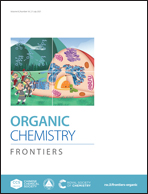Assembling triazolated calix[4]semitubes by means of copper(i)-catalyzed azide–alkyne cycloaddition†‡
Abstract
Nine pairs of cone and 1,3-alternate calix[4]arenes having distal propargyl or 2-azidoethyl groups at their phenolic oxygen atoms were thoroughly studied during macrocyclization under copper(I) catalysis (CuAAC, copper(I)-catalyzed azide–alkyne cycloaddition). Though the formation of undesired polymeric species was not avoidable, the conditions for the preparation and purification of calix[4]semitubes comprising two calixarenes linked by two triazole units were found for all the bis(alkyne)/bis(azide) combinations, and the features of the reacting counterparts which affected the semitube/polymer ratio were analyzed. Formation of larger multi(macrocycles) was also observed in the interactions of sterically hindered bis(alkyne)/bis(azide) pairs under CuAAC conditions that was confirmed by mass spectrometry and diffusion NMR measurements. The molecular structures of the prepared triazolated multi(macrocycles) were confirmed using X-ray diffraction data in most cases. A preliminary complexation study demonstrated the ability of the triazolated calix[4]semitubes to bind Zn2+ or Ag+ cations, which was managed by the shape of the calixarene core (cone or 1,3-alternate) at the ‘alkyne sides’ of the semitubes and the steric hindrance in the molecules of the bis(calixarenes).
![Graphical abstract: Assembling triazolated calix[4]semitubes by means of copper(i)-catalyzed azide–alkyne cycloaddition](/en/Image/Get?imageInfo.ImageType=GA&imageInfo.ImageIdentifier.ManuscriptID=D1QO00636C&imageInfo.ImageIdentifier.Year=2021)


 Please wait while we load your content...
Please wait while we load your content...